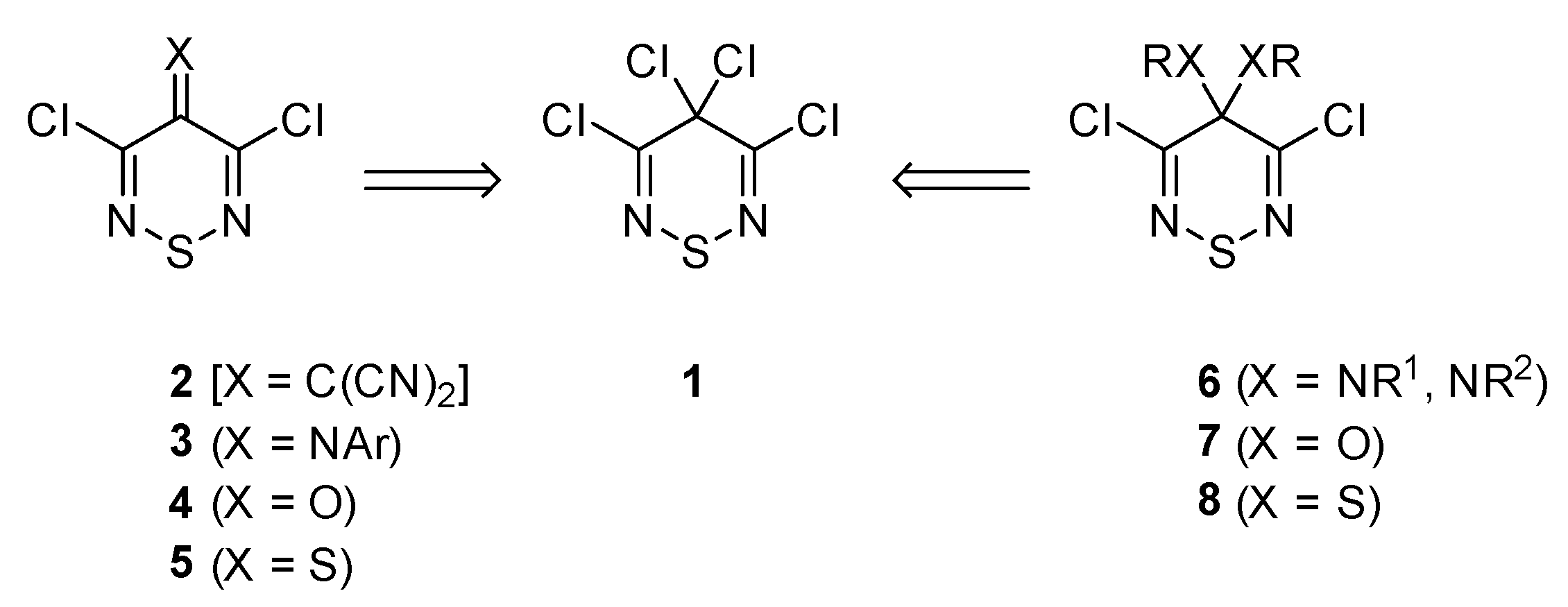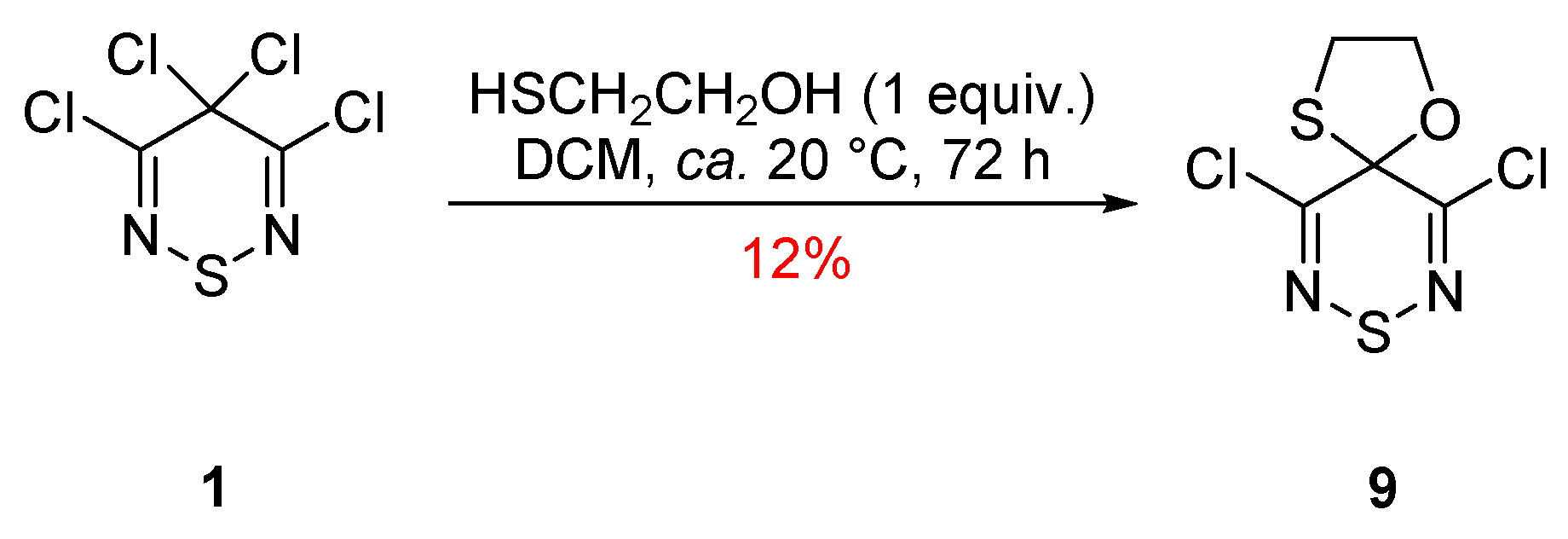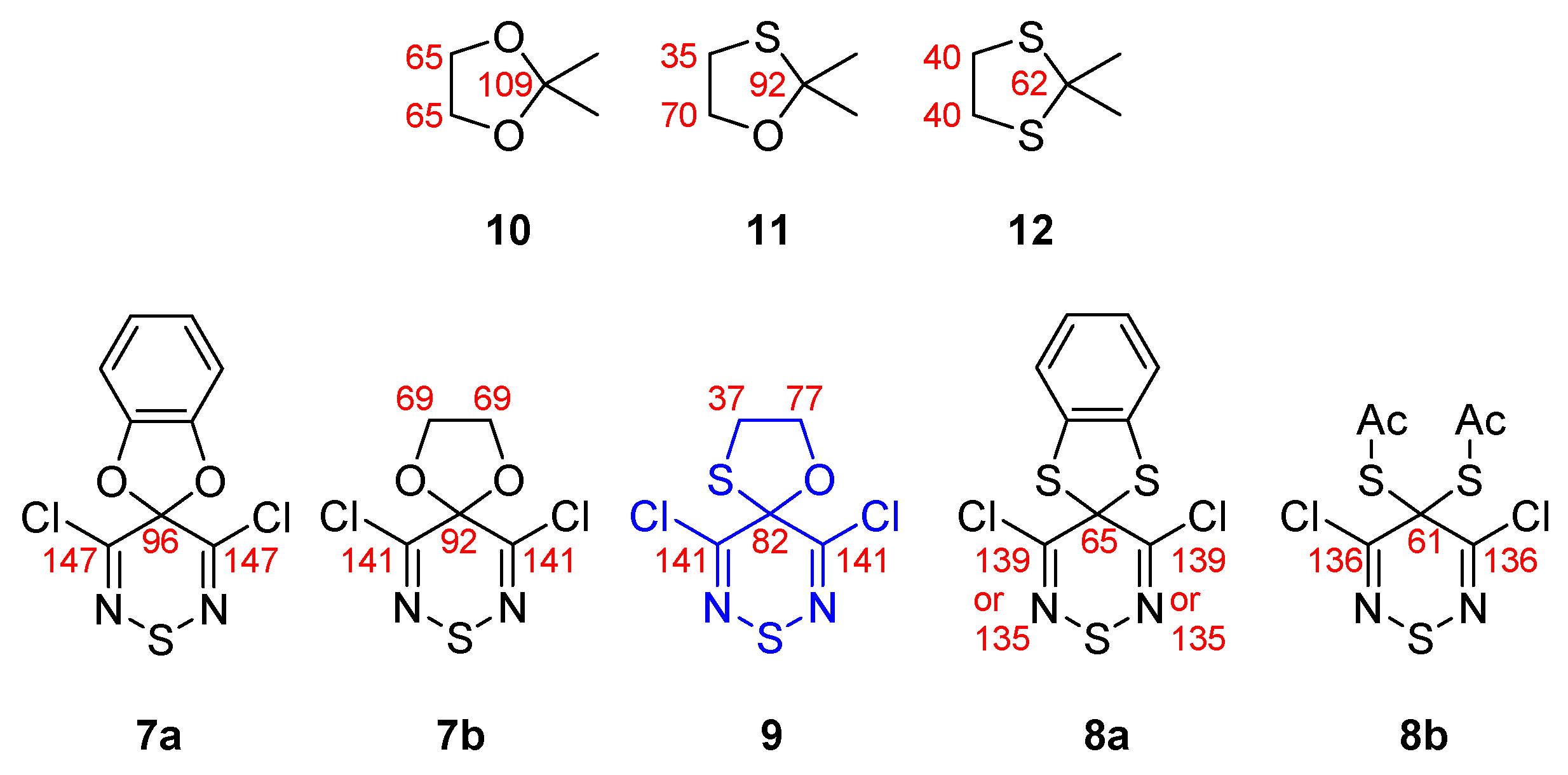6,10-Dichloro-1-oxa-4,8-dithia-7,9-diazaspiro[4.5]deca-6,9-diene
Abstract
:1. Introduction
2. Results and Discussion
3. Materials and Methods
6,10-Dichloro-1-oxa-4,8-dithia-7,9-diazaspiro[4.5]deca-6,9-diene (9)
Supplementary Materials
Author Contributions
Funding
Data Availability Statement
Acknowledgments
Conflicts of Interest
References
- Kalogirou, A.S. Comprehensive Heterocyclic Chemistry IV; Black, D.S., Cossy, J., Stevens, C.V., Eds.; Elsevier: Oxford, UK, 2022; Volume 9, Chapter 9.07; pp. 363–401. [Google Scholar]
- Gómez, T.; Macho, S.; Miguel, D.; Neo, A.G.; Rodríguez, T.; Torroba, T. Cyclopentathiadiazines, cyclohepta- and cyclopentadithiazoles: New materials and a rich heterocyclic chemistry of cyclic enaminonitriles. Eur. J. Org. Chem. 2005, 2005, 5055–5066. [Google Scholar] [CrossRef]
- Hermerschmidt, F.; Kalogirou, A.S.; Min, J.; Zissimou, G.A.; Tuladhar, S.M.; Ameri, T.; Faber, H.; Itskos, G.; Choulis, S.A.; Anthopoulos, T.D.; et al. 4H-1,2,6-Thiadiazin-4-one-containing small molecule donors and additive effects on their performance in solution-processed organic solar cells. J. Mater. Chem. C 2015, 3, 2358–2365. [Google Scholar] [CrossRef] [Green Version]
- Chochos, C.L.; Kalogirou, A.S.; Ye, T.; Tatsi, E.; Katsouras, A.; Zissimou, G.A.; Gregoriou, V.G.; Avgeropoulos, A.; Koutentis, P.A. 4H-1,2,6-Thiadiazine-containing donor–acceptor conjugated polymers: Synthesis, optoelectronic characterization and their use in organic solar cells. J. Mater. Chem. C 2018, 6, 3658–3667. [Google Scholar] [CrossRef]
- Peake, C.J.; Harnish, W.N.; Davidson, B.L. Mono-5-Substituted-3-Chloro-4H-1,2,6-Thiadiazin-4-One Antifungal Agents. U.S. Patent 4,097,594A, 27 June 1978. [Google Scholar]
- Peake, C.J.; Harnish, W.N.; Davidson, B.L. Mono-5-Substituted-thio-3-Chloro-4H-1,2,6-Thiadiazin-4-One Antifungal Agents. U.S. Patent 4,100,281A, 27 June 1978. [Google Scholar]
- Peake, C.J.; Harnish, W.N.; Davidson, B.L. 3-Chloro-5-(Optionally Substituted Heterocycloxy)-4H-1,2,6-Thiadiazin-4-One Antifungal Agents. U.S. Patent 4,143,138, 3 March 1979. [Google Scholar]
- Peake, C.J.; Harnish, W.N.; Davidson, B.L. Mono-5-Substituted-3-Chloro-4H-1,2,6-Thiadiazin-4-One Antifungal Agents. U.S. Patent 4,201,780, 6 May 1980. [Google Scholar]
- Portnoy, R.C. Thiadiazinone Plant Disease Control Agents. U.S. Patent 4,497,807A, 5 February 1985. [Google Scholar]
- Asquith, C.R.M.; Godoi, P.H.; Couñago, R.M.; Laitinen, T.; Scott, J.W.; Langendorf, C.G.; Oakhill, J.S.; Drewry, D.H.; Zuercher, W.J.; Koutentis, P.A.; et al. 1,2,6-Thiadiazinones as Novel Narrow Spectrum Calcium/Calmodulin-Dependent Protein Kinase Kinase 2 (CaMKK2) Inhibitors. Molecules 2018, 23, 1221. [Google Scholar] [CrossRef] [PubMed] [Green Version]
- Kalogirou, A.S.; East, M.P.; Laitinen, T.; Torrice, C.D.; Maffuid, K.A.; Drewry, D.H.; Koutentis, P.A.; Johnson, G.L.; Crona, D.J.; Asquith, C.R.M. Synthesis and Evaluation of Novel 1,2,6-Thiadiazinone Kinase Inhibitors as Potent Inhibitors of Solid Tumors. Molecules 2021, 26, 5911. [Google Scholar] [CrossRef] [PubMed]
- Kalogirou, A.S.; Koutentis, P.A. The chemistry of non-S-oxidised 4H-1,2,6-thiadiazines. Targets Heterocycl. Syst. 2018, 22, 82–118. [Google Scholar] [CrossRef]
- Geevers, J.; Trompen, W.P. Synthesis and reactions of 3,5-dichloro-4H-1,2,6-thiadiazin-4-one. Recl. Trav. Chim. Pays-Bas 1974, 93, 270–272. [Google Scholar] [CrossRef]
- Carpenter, W.R.; Armstrong, P. N-1,1-Trichlorocyanoacetimidoyl Chloride. J. Org. Chem. 1964, 29, 2772–2774. [Google Scholar] [CrossRef]
- Kalogirou, A.S.; Koutentis, P.A. A Qualitative Comparison of the Reactivities of 3,4,4,5-Tetrachloro-4H-1,2,6-thiadiazine and 4,5-Dichloro-1,2,3-dithiazolium Chloride. Molecules 2015, 20, 14576–14594. [Google Scholar] [CrossRef] [PubMed] [Green Version]
- Kalogirou, A.S.; Manoli, M.; Koutentis, P.A. Synthesis of N-Aryl-3,5-dichloro-4H-1,2,6-thiadiazin-4-imines from 3,4,4,5-Tetrachloro-4H-1,2,6-thiadiazine. Org. Lett. 2015, 17, 4118–4121. [Google Scholar] [CrossRef] [PubMed]
- Kalogirou, A.S.; Koutentis, P.A. Regioselective geminal dichloride reactivity of 3,4,4,5-tetrachloro-4H-1,2,6-thiadiazine: Access to 4,4-dioxo- and dithio-ketals. Tetrahedron Lett. 2016, 57, 203–205. [Google Scholar] [CrossRef]
- Kalogirou, A.S.; Kourtellaris, A.; Koutentis, P.A. Synthesis and Reactivity of 3′,5′-Dichloro-1H-spiro(quinazoline-2,4′-[1,2,6]thiadiazin)-4(3H)-ones. Eur. J. Org. Chem. 2019, 2019, 5462–5474. [Google Scholar] [CrossRef]
- Chavan, S.P.; Soni, P.; Kamat, S.K. Chemoselective Deprotection Of 1,3-Oxathiolanes Using Amberlyst 15 and Glyoxylic Acid under Solvent Free Conditions. Synlett 2001, 2001, 1251–1252. [Google Scholar] [CrossRef]
- Pihlaja, K.; Nummelin, H.; Klika, K.D.; Czombos, J. 1H, 13C and 17O NMR spectral studies on monocyclic dioxolanes, dioxanes, dioxepanes and dioxocanes and cycloalkane-fused (5–8-membered) bicyclic 1,3-dioxolanes and 1,3-dioxanes. Magn. Reson. Chem. 2001, 39, 657–671. [Google Scholar] [CrossRef]
- Gokel, J.W.; Gerdes, H.M.; Dishong, D.M. Sulfur Heterocycles. 3. Heterogeneous, Phase-Transfer, and Acid-Catalyzed Potassium Permanganate Oxidation of Sulfides to Sulfones and a Survey of their Carbon-13 Nuclear Magnetic Resonance Spectra. J. Org. Chem. 1980, 45, 3634–3639. [Google Scholar] [CrossRef]
- Pihlaja, K.; Eskonmaa, M.; Keskinen, R.; Nikkila, A.; Nurmi, T. Conformational Analysis XX-13C NMR Studies of Saturated Heterocycles 5-Substituent Effects on the 13C Chemical Shifts of Methyl Substituted 1,3-Dithiolanes. Org. Magn. Reson. 1981, 17, 246–249. [Google Scholar] [CrossRef]
- Harwood, L.M. “Dry-Column” Flash Chromatography. Aldrichimica Acta 1985, 18, 25. [Google Scholar]



Publisher’s Note: MDPI stays neutral with regard to jurisdictional claims in published maps and institutional affiliations. |
© 2022 by the authors. Licensee MDPI, Basel, Switzerland. This article is an open access article distributed under the terms and conditions of the Creative Commons Attribution (CC BY) license (https://creativecommons.org/licenses/by/4.0/).
Share and Cite
Kalogirou, A.S.; Koutentis, P.A. 6,10-Dichloro-1-oxa-4,8-dithia-7,9-diazaspiro[4.5]deca-6,9-diene. Molbank 2022, 2022, M1377. https://doi.org/10.3390/M1377
Kalogirou AS, Koutentis PA. 6,10-Dichloro-1-oxa-4,8-dithia-7,9-diazaspiro[4.5]deca-6,9-diene. Molbank. 2022; 2022(2):M1377. https://doi.org/10.3390/M1377
Chicago/Turabian StyleKalogirou, Andreas S., and Panayiotis A. Koutentis. 2022. "6,10-Dichloro-1-oxa-4,8-dithia-7,9-diazaspiro[4.5]deca-6,9-diene" Molbank 2022, no. 2: M1377. https://doi.org/10.3390/M1377
APA StyleKalogirou, A. S., & Koutentis, P. A. (2022). 6,10-Dichloro-1-oxa-4,8-dithia-7,9-diazaspiro[4.5]deca-6,9-diene. Molbank, 2022(2), M1377. https://doi.org/10.3390/M1377






